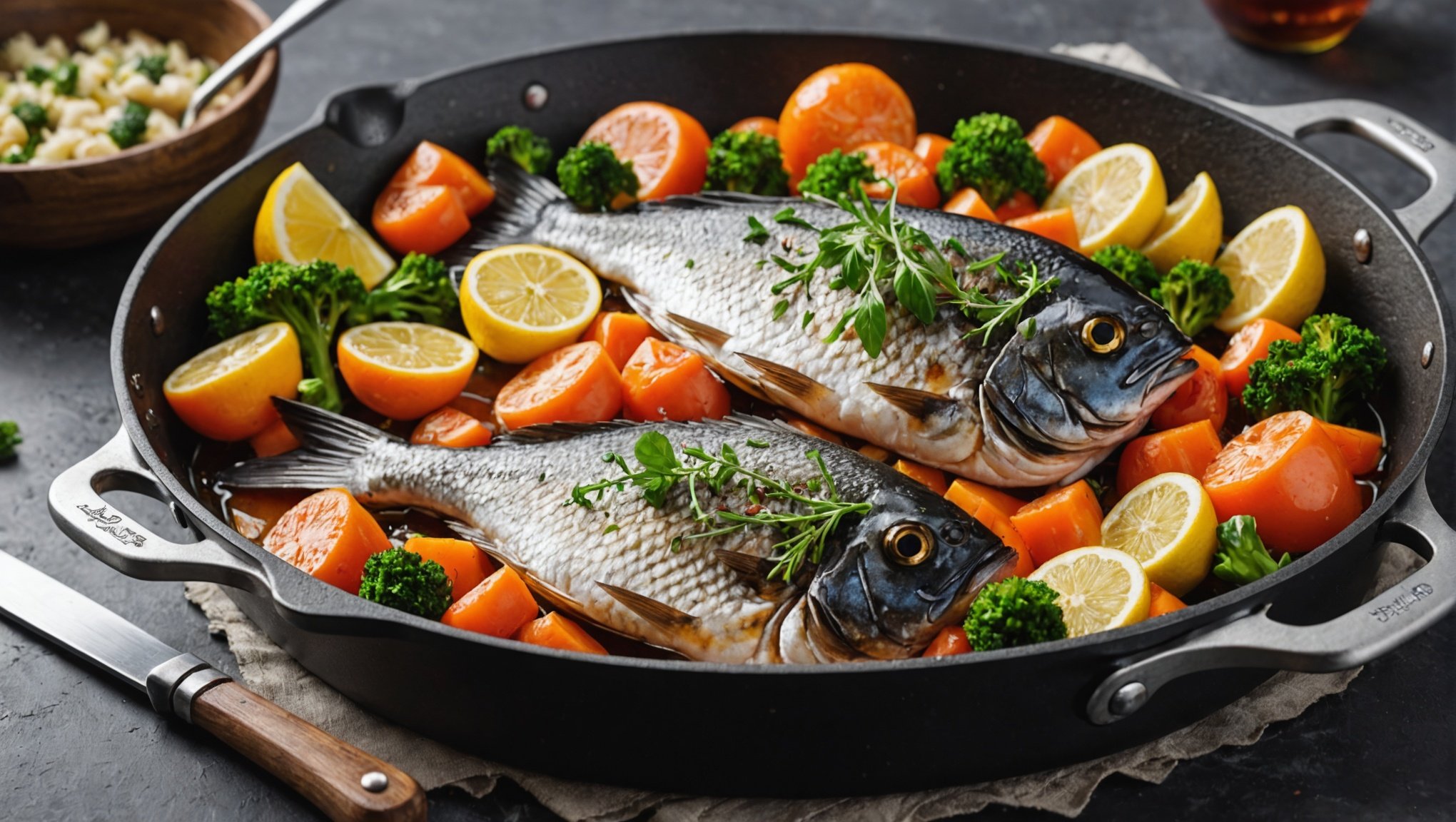Cooking fish can be healthy and delicious, but the right tools make all the difference. A good fish poacher can elevate your culinary skills, ensuring perfectly tender, flaky results every time. This guide provides essential insights for health-conscious chefs on selecting the ideal fish poacher tailored to your cooking habits and health goals. Explore options that combine usability with style, enabling you to create scrumptious, nutritious meals effortlessly. Your journey to becoming a fish poaching expert starts here.
Overview of Fish Poaching
Fish poaching is a cooking technique that involves gently simmering fish in a liquid. This method dates back centuries and has been a staple in various culinary traditions. The history of fish poaching is rich, with roots in European and Asian cuisines, where it was valued for its ability to preserve the delicate flavours and textures of fish.
Also to discover : Mastering Safe Mandoline Slicing: Top Techniques for Injury-Free Food Prep
One of the primary benefits of poaching is its alignment with healthy meals. Unlike frying or grilling, poaching does not require added fats, making it an excellent choice for those seeking nutritious options. The technique helps retain the fish’s natural nutrients, ensuring a wholesome dish.
There are several types of fish that are particularly well-suited for poaching. Common choices include salmon, cod, and trout, all of which maintain their integrity and flavour when cooked using this method. These fish are not only versatile but also widely available, making them popular options for home cooks and professional chefs alike.
Also read : Unlocking the Perfect Pizza: Essential Features of a Pizza Stone for Crispy Crusts in Your Home Oven
Incorporating fish poaching into your cooking repertoire can elevate your meals, offering a health-conscious alternative that does not compromise on taste. By understanding the nuances of this technique, you can create dishes that are both delicious and beneficial to your well-being.
Types of Fish Poachers
When it comes to kitchen equipment for poaching fish, there are several types of fish poachers to consider. Each offers unique features and benefits, making them valuable cooking tools.
Traditional vs. Modern Fish Poachers
Traditional fish poachers are typically made of stainless steel or copper and are designed for stovetop use. These poachers often come with a rack to hold the fish above the simmering liquid, ensuring even cooking. Modern fish poachers, on the other hand, may incorporate non-stick surfaces and are often more lightweight. They can be easier to clean and store, making them a practical choice for contemporary kitchens.
Electric Fish Poachers and Their Advantages
Electric fish poachers are a modern innovation, offering convenience and precision. They allow for precise temperature control, which is crucial for maintaining the delicate texture of poached fish. These poachers often come with timers and automatic shut-off features, reducing the risk of overcooking. This makes them an excellent choice for those seeking a hassle-free poaching experience.
Stovetop Poachers and Their Features
Stovetop poachers remain popular due to their versatility. They can be used on various heat sources, including gas and electric stoves. Many stovetop poachers have a long, oval shape, accommodating whole fish or fillets. This ensures that the fish cooks evenly, preserving its texture and flavour.
Materials Used in Fish Poachers
Selecting the right fish poacher materials is essential for achieving the best cooking results. The most common materials include stainless steel, non-stick, and ceramic, each offering unique benefits and drawbacks.
Stainless Steel
Stainless steel is a popular choice due to its durability and heat conductivity. It provides even heat distribution, which is crucial for the delicate process of poaching. However, stainless steel poachers can be heavier and require more maintenance to prevent staining.
Non-Stick
Non-stick poachers are favoured for their easy cleanup and lightweight nature. They prevent the fish from sticking, ensuring that the delicate flesh remains intact. However, they may not distribute heat as evenly as stainless steel, potentially affecting cooking performance.
Ceramic
Ceramic poachers are celebrated for their aesthetic appeal and even heat distribution. They are often non-reactive, preserving the pure taste of the fish. Yet, they can be more fragile and require careful handling to prevent chipping.
When choosing a poacher, consider how each material affects both cooking performance and health. Stainless steel offers robustness, non-stick ensures ease, and ceramic provides a balance of beauty and function.
Cooking Techniques for Fish Poaching
Mastering fish poaching techniques can enhance your culinary skills and elevate your healthy cooking repertoire. This method requires precision and attention to detail to ensure the fish remains tender and flavorful.
Step-by-Step Guide on Poaching Fish
- Select Your Fish: Choose fresh fish like salmon or cod, known for their poaching suitability.
- Prepare the Liquid: Use a poaching liquid such as water, broth, or wine. Add aromatics like herbs, lemon slices, and spices for enhanced flavor.
- Heat the Liquid: Bring the liquid to a gentle simmer, ensuring it does not boil, as high temperatures can toughen the fish.
- Add the Fish: Place the fish in the poaching liquid, ensuring it is fully submerged.
- Monitor Temperature: Maintain a temperature between 160°F and 180°F (71°C to 82°C) for optimal results.
- Timing is Key: Poach for 10-15 minutes, depending on the thickness of the fish.
Best Practices for Seasoning and Flavoring
- Use fresh herbs like dill or parsley for a subtle aroma.
- Incorporate citrus elements such as lemon or lime for a refreshing taste.
- Add a pinch of salt and pepper to enhance natural flavors.
By focusing on temperature control and timing, you can achieve perfectly poached fish every time.
Health Benefits of Poaching Fish
Poaching fish offers numerous health benefits, making it an ideal choice for nutritious meals. This gentle cooking method not only enhances the flavour but also preserves the fish’s natural nutrients. Unlike other cooking methods, poaching requires no additional fats or oils, allowing the fish’s healthy fats to remain intact.
Nutritional Advantages of Poached Fish
Poached fish retains essential nutrients such as omega-3 fatty acids, which are crucial for heart health. These fats are often lost in high-heat cooking methods like frying or grilling. By maintaining a lower temperature, poaching helps preserve these beneficial nutrients, ensuring a wholesome dish.
Comparison of Poaching vs. Other Cooking Methods
When comparing poaching to methods like frying, the nutritional superiority becomes evident. Frying can introduce unhealthy trans fats, while poaching keeps the dish light and healthy. Grilling, another popular method, can sometimes lead to nutrient loss due to high heat exposure. Poaching, however, maintains the integrity of the fish, offering a healthier alternative.
How Poaching Preserves Healthy Fats and Nutrients
The low and consistent temperature of poaching is key to preserving the fish’s healthy components. This method ensures that vitamins, minerals, and omega-3s remain intact, providing a nutrient-rich meal. By choosing poaching, you can enjoy delicious fish dishes without compromising on nutrition.
Maintenance and Care for Fish Poachers
Proper fish poacher maintenance is crucial to ensure its longevity and optimal performance. Different materials require specific cleaning techniques to maintain their integrity and function.
Best Practices for Cleaning
For stainless steel poachers, use a non-abrasive sponge and mild detergent to avoid scratching the surface. Rinse thoroughly and dry immediately to prevent water spots. Non-stick poachers should be cleaned with a soft cloth to protect the coating. Avoid metal utensils that can damage the surface. Ceramic poachers benefit from gentle hand washing with warm, soapy water, as dishwashers may cause chipping.
Tips for Prolonging the Life of Your Fish Poacher
- Regular Cleaning: Clean your poacher after each use to prevent residue build-up.
- Avoid High Heat: Excessive heat can warp or damage the poacher, reducing its effectiveness.
- Storage: Store your poacher in a dry place to prevent rust and damage.
Common Issues and Troubleshooting Advice
If you notice uneven cooking, check for warping or damage to the poacher. Sticking issues in non-stick poachers may indicate a worn coating, requiring replacement. Regular inspections can help identify potential problems early, ensuring your poacher remains a reliable kitchen tool. By following these cleaning tips and maintenance practices, you can extend your poacher’s life and enhance your cooking experience.
User Reviews and Recommendations
Exploring fish poacher reviews can guide you toward the best choice for your kitchen. User feedback often highlights the strengths and weaknesses of popular brands, providing valuable insights for potential buyers.
Overview of Popular Fish Poacher Brands
Brands like Cuisinart, All-Clad, and T-fal frequently appear in user feedback due to their quality and durability. Cuisinart is praised for its stainless steel options, while All-Clad offers premium, long-lasting products. T-fal, known for its non-stick features, is often recommended for easy maintenance.
Analysis of Top-Rated Products
Based on user reviews, the Cuisinart Classic Fish Poacher stands out for its robust construction and even heat distribution. All-Clad’s Stainless Steel Fish Poacher is celebrated for its professional-grade quality, though it comes at a higher price. T-fal’s non-stick poacher is favoured for its affordability and ease of use, making it ideal for beginners.
Price Comparisons and Value
For health-conscious chefs, balancing product recommendations with budget is crucial. Cuisinart offers mid-range pricing with durable results, while All-Clad, though pricier, ensures longevity. T-fal provides cost-effective solutions without compromising on essential features. Evaluating these factors can help make an informed decision.
Visual Demonstrations and Recipes
Exploring fish poaching recipes can transform your culinary experience, offering delicious and healthy meal options. To master this technique, consider utilizing cooking demonstrations and visual aids available online. These resources provide step-by-step guidance, ensuring you can replicate professional results at home.
Suggested Recipes for Poached Fish Dishes
- Lemon Herb Poached Salmon: A classic recipe that combines the freshness of lemon and herbs to enhance the natural flavours of salmon.
- Wine-Poached Cod with Vegetables: This dish uses white wine and a medley of vegetables, creating a savoury and aromatic meal.
- Ginger Soy Poached Trout: Infuse Asian flavours with ginger and soy sauce for a unique twist on traditional poaching.
Video Demonstrations for Proper Poaching Techniques
Online video demonstrations are invaluable for learning the nuances of fish poaching. These videos show the correct simmering temperatures and techniques, allowing you to visualize the process and avoid common mistakes.
Tips for Plating and Presentation
Once poached, presenting your fish with flair can elevate your dish. Consider garnishing with fresh herbs or citrus slices. Use a clean, white plate to highlight the colours of the fish and accompaniments, creating an appetizing and visually appealing meal.
Where to Buy the Best Fish Poachers
Navigating the world of kitchen equipment shopping can be daunting, especially when seeking the best fish poachers. Fortunately, both online retailers and physical stores offer a variety of options to suit different preferences and budgets.
Best Online and In-Store Sources for Purchasing
For those interested in buying fish poachers, popular online retailers like Amazon and Wayfair provide extensive selections with user reviews to guide your choice. In-store options include well-known chains such as Bed Bath & Beyond and Williams-Sonoma, where you can physically inspect the poachers.
Price Range and Budget Considerations
When it comes to budget, fish poachers vary widely in price. Entry-level models can start as low as £20, while premium options, particularly those made from high-quality materials like stainless steel, may exceed £100. Consider your budget and cooking needs before making a purchase.
Recommendations for Seasonal Sales or Discounts
Timing your purchase can lead to significant savings. Keep an eye out for seasonal sales and discounts, particularly during Black Friday or end-of-season clearances. These events often offer opportunities to buy high-quality fish poachers at reduced prices, making it easier to equip your kitchen without breaking the bank.
Conclusion and Final Thoughts
Choosing the right fish poacher can significantly enhance your culinary experience, especially if you’re focused on healthy cooking. This article has highlighted the importance of selecting quality kitchen tools, which are essential for maintaining the integrity and flavour of poached fish. A good poacher not only ensures even cooking but also preserves the fish’s natural nutrients.
When considering a fish poacher, remember the key points: assess your needs, budget, and the types of fish you plan to cook. Investing in a durable and efficient poacher will pay off in the long run, offering consistent results and healthier meals. Whether you opt for a traditional stovetop model or a modern electric version, the right choice can make all the difference.
Experimenting with different techniques and recipes can also elevate your cooking skills. By trying various poaching liquids and seasonings, you can discover new flavours and textures, making your meals both exciting and nutritious. Embrace the versatility of fish poaching as a method for creating delicious, health-conscious dishes. With the right tools and a bit of creativity, you can transform your kitchen into a hub of culinary exploration.






